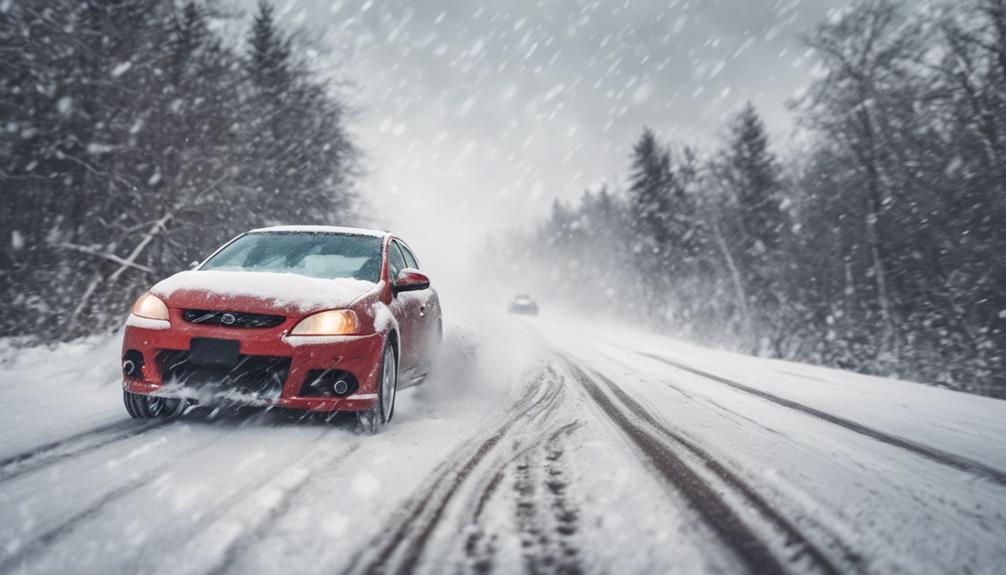Why Is Safe Snowy Road Tripping Essential?
Driving on snowy roads can be treacherous, especially when unexpected weather hits. As a responsible driver, you know the importance of arriving safely at your destination. But have you considered all the factors that contribute to safe winter road tripping?
Stay tuned to discover why safe snowy road tripping is not just about reaching your endpoint—it's about ensuring a smooth journey for you and your passengers.
Understanding Road Weather Conditions
To navigate safely through winter roads, grasp the importance of understanding road weather conditions. Keeping an eye on weather advisories is crucial before embarking on a snowy road trip. These advisories provide valuable information about upcoming weather patterns, allowing you to plan your journey accordingly and avoid potential hazards. By staying informed about changing weather conditions, you can adjust your route or schedule to ensure a smoother and safer travel experience.
In addition to monitoring weather advisories, it's vital to stay updated on road closures. Snow and ice can lead to unexpected road closures, causing delays and detours in your travel plans. Being aware of any closures ahead of time can help you avoid getting stuck in traffic or stranded on a closed-off route. Checking for road closures before you set out on your trip can save you time and frustration, enabling you to make alternative arrangements if needed.
Preparing Your Vehicle for Snow
Ensure your vehicle is equipped to handle snowy conditions by preparing it for the challenges of winter driving. One of the most important steps you can take is to invest in winter tires. Winter tires are specifically designed to provide better traction, handling, and braking on snow and ice-covered roads compared to all-season tires. They're made of a softer rubber compound that stays flexible in cold temperatures, allowing them to grip the road better. Additionally, the tread patterns on winter tires are designed to evacuate snow and slush, further enhancing their performance in snowy conditions.
In some situations, especially in areas with heavy snowfall or icy roads, having tire chains can be beneficial. Tire chains are metal chains that wrap around your tires to provide additional traction when driving on extremely slippery surfaces. They can significantly improve your vehicle's grip on the road, reducing the chances of skidding or getting stuck in the snow. It's important to practice putting on and taking off tire chains before you actually need them, as doing so in freezing conditions on the side of the road can be challenging.
Adjusting Your Driving Technique
When navigating snowy roads, adapting your driving technique is crucial for maintaining control and safety. In winter conditions, it's vital to adjust your driving to the reduced traction. To enhance your winter traction, drive at a slower speed than usual and avoid sudden movements such as hard braking or sharp turns. Smooth and gradual actions are key to preventing skidding on slippery roads. Defensive driving is especially important in snowy conditions. Keep a safe distance from the vehicle in front of you, as it takes longer to stop on snowy roads. Anticipate potential hazards and be prepared to react calmly and promptly if needed.
Remember to accelerate gently to avoid spinning your wheels and losing traction. If your vehicle starts to skid, steer gently in the direction you want to go without overcorrecting. Don't use cruise control on snowy or icy roads, as you need full control over acceleration and deceleration. Be extra cautious on bridges, ramps, and shaded areas where ice tends to form first. Utilize your headlights to increase visibility, and always clear snow and ice from all windows before setting off. By adjusting your driving technique to suit snowy conditions and practicing defensive driving, you'll significantly reduce the risk of accidents and arrive safely at your destination.
Packing Emergency Supplies
Make sure you pack essential emergency supplies before embarking on a snowy road trip. Winter survival is crucial when facing challenging weather conditions. An emergency kit could be a lifesaver in unexpected situations. Here's what you should include in your emergency supplies:
Firstly, pack items to keep you warm. Make sure to have extra blankets, gloves, hats, and hand warmers in your vehicle. These can provide much-needed warmth if you're stranded or facing a breakdown in cold temperatures. Additionally, include high-energy snacks like granola bars, nuts, and dried fruits to keep your energy levels up during an emergency.
Secondly, a well-stocked first aid kit is essential. Include basic medical supplies such as bandages, antiseptic wipes, pain relievers, and any necessary medications. In case of an injury, having these supplies readily available can make a significant difference.
Next, carry tools like a flashlight, extra batteries, a multi-tool, and a portable shovel. These tools can help you navigate through unexpected situations like getting stuck in the snow. A flashlight is especially useful during dark winter nights when visibility is low.
Lastly, include items like a fully charged phone, emergency contact numbers, and a physical map in your emergency kit. These items can help you stay connected and find your way in case of an emergency. Remember, being prepared with the right supplies can make all the difference in ensuring your safety during a snowy road trip.
Checking Road Conditions Before Departure
Before you begin your snowy road trip, it's crucial to check the road conditions to ensure a safe journey. Start by verifying that your vehicle is equipped with winter tires. These tires are designed to provide better traction and handling on snow-covered roads, enhancing your safety during winter driving conditions.
One of the most convenient ways to check road conditions is by using weather apps. These apps can provide real-time updates on weather patterns, road closures, and traffic conditions along your route. Before you hit the road, take a few moments to review the weather forecast for your destination and any areas you'll be passing through. This information can help you anticipate potential challenges and plan your trip accordingly.
In addition to checking the weather, consider looking up live traffic updates on your chosen route. This will give you valuable insights into any accidents, road work, or other hazards that could affect your journey. By staying informed about road conditions, you can make informed decisions about when to leave, which route to take, and where to stop along the way.
Taking the time to check road conditions before departure is a simple yet effective way to prioritize your safety during winter road trips. By arming yourself with information and being prepared, you can enjoy a smoother and more secure journey to your destination.
Maintaining a Safe Following Distance
To ensure a safe winter road trip, maintain a proper following distance between your vehicle and the one ahead of you. Keeping a safe distance allows for adequate reaction time in case the vehicle in front suddenly brakes. In snowy conditions, your braking distance increases due to reduced traction, so having enough space ahead of you is crucial for a safe stop.
During winter road trips, visibility challenges can arise from snowfall or blowing snow. By maintaining a safe following distance, you provide yourself with a clearer view of the road ahead. This extra space gives you more time to react to any unexpected obstacles or changes in road conditions, helping you avoid potential accidents.
Knowing How to Handle Skids

Stay calm and steer into the skid to regain control of your vehicle when encountering slippery road conditions. Skids can be frightening, but knowing how to handle them can prevent accidents and ensure a safe journey. Skid prevention starts with maintaining proper tire pressure and ensuring your tires have enough tread to grip the road. Additionally, driving at a moderate speed and avoiding sudden movements can help reduce the risk of skidding.
When you find yourself in a skid, remember to stay calm and avoid overreacting. Keep your hands on the steering wheel and gently turn it in the direction of the skid. This action helps you regain steering control and allows the wheels to regain traction. Avoid slamming on the brakes, as this can worsen the skid. Instead, apply gentle pressure to the brakes or release them altogether until you have control of the vehicle.
Quick recovery from a skid relies on your ability to react swiftly but calmly. Practice steering control and braking techniques in a safe environment to familiarize yourself with how your vehicle responds in slippery conditions. By staying alert and prepared, you can navigate through skids safely and enjoy a smooth winter road trip.
Planning for Alternative Routes
When encountering unexpected road closures or heavy traffic due to inclement weather, considering alternative routes can help you reach your destination safely and efficiently. Here are some tips to help you plan for alternative routes:
- Route flexibility: Always have a couple of backup routes in mind before starting your journey. Knowing alternative roads can save you time and stress if your primary route becomes impassable.
- Use GPS navigation: Make sure to utilize GPS navigation systems or apps that provide real-time traffic updates and suggest alternative routes. These tools can help you navigate unfamiliar roads effectively.
- Plan for detours: When driving in snowy conditions, road closures are common. Be prepared to take detours by checking for road closure information ahead of time and adjusting your route accordingly.
- Have backups: In case your GPS fails or signal is lost, always carry paper maps or have a general idea of the area's layout. This backup plan can prevent you from getting lost in case of technological failures.
Frequently Asked Questions
Are Snow Chains Necessary for Driving on Snowy Roads?
When winter driving on snowy roads, snow chains can be necessary for better tire traction. They provide additional grip and help you maintain control of your vehicle in slippery conditions.
Always check if they're required in the areas you're traveling to ensure a safer journey. Remember, it's better to be prepared with snow chains and not need them than to risk safety on icy roads.
What Should I Do if My Car Gets Stuck in the Snow?
If your car gets stuck in the snow, first remain calm.
Try clearing the snow around the tires and placing traction aids like sand or cat litter.
If that doesn't work, consider calling for snow removal services or a towing company.
Stay inside your vehicle to stay warm and safe while waiting for help.
How Can I Prevent My Car From Sliding on Icy Roads?
To prevent your car from sliding on icy roads, make sure you have winter tires. They're effective in providing better traction on slippery surfaces.
Also, be cautious of black ice by taking precautions like reducing your speed, avoiding sudden movements, and increasing following distance.
These steps can help you stay safe and in control while driving on icy roads during the winter months.
Are There Any Specific Emergency Supplies I Should Pack for Winter Road Trips?
When preparing for winter road trips, it's crucial to pack specific emergency supplies. Make sure you have emergency food like energy bars and water to keep you nourished.
Don't forget to pack warm winter clothing like hats, gloves, and blankets to stay cozy if you get stranded.
These supplies can make a big difference in ensuring your safety and well-being during winter travels.
How Often Should I Check Road Conditions During a Long Winter Road Trip?
When embarking on a long winter road trip, make sure to check road conditions frequently. Stay updated with weather reports and road closures. It's essential to ensure your safety and plan alternate routes if needed.
Conclusion
Remember, safe snowy road tripping is essential for your well-being and the safety of others on the road.
By understanding road weather conditions, preparing your vehicle, adjusting your driving technique, packing emergency supplies, checking road conditions, maintaining a safe following distance, knowing how to handle skids, and planning for alternative routes, you can ensure a smooth and safe winter road trip.
Stay safe out there!
